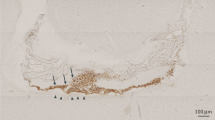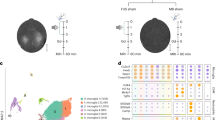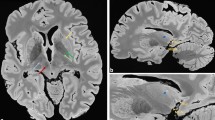Abstract
Multiple sclerosis is a disease of the central nervous system that is associated with leukocyte recruitment and subsequent inflammation, demyelination and axonal loss. Endothelial vascular cell adhesion molecule-1 (VCAM-1) and its ligand, α4β1 integrin, are key mediators of leukocyte recruitment, and selective inhibitors that bind to the α4 subunit of α4β1 substantially reduce clinical relapse in multiple sclerosis. Urgently needed is a molecular imaging technique to accelerate diagnosis, to quantify disease activity and to guide specific therapy. Here we report in vivo detection of VCAM-1 in acute brain inflammation, by magnetic resonance imaging in a mouse model, at a time when pathology is otherwise undetectable. Antibody-conjugated microparticles carrying a large amount of iron oxide provide potent, quantifiable contrast effects that delineate the architecture of activated cerebral blood vessels. Their rapid clearance from blood results in minimal background contrast. This technology is adaptable to monitor the expression of endovascular molecules in vivo in various pathologies.
This is a preview of subscription content, access via your institution
Access options
Subscribe to this journal
Receive 12 print issues and online access
$209.00 per year
only $17.42 per issue
Buy this article
- Purchase on Springer Link
- Instant access to full article PDF
Prices may be subject to local taxes which are calculated during checkout





Similar content being viewed by others
References
Compston, A. & Coles, A. Multiple sclerosis. Lancet 359, 1221–1231 (2002).
McDonald, W.I. et al. Recommended diagnostic criteria for multiple sclerosis: guidelines from the International Panel on the Diagnosis of Multiple Sclerosis. Ann. Neurol. 50, 121–127 (2001).
Polman, C.H. et al. Diagnostic criteria for multiple sclerosis: 2005 revisions to the 'McDonald Criteria'. Ann. Neurol. 58, 840–846 (2005).
Goldberg-Zimring, D., Mewes, A.U.J., Maddah, M. & Warfield, S.K. Diffusion tensor magnetic resonance imaging in multiple sclerosis. J. Neuroimaging 15, 68S–81S (2005).
Ropele, S. et al. A comparison of magnetization transfer ratio, magnetization transfer rate, and the native relaxation time of water protons related to relapsing-remitting multiple sclerosis. AJNR Am. J. Neuroradiol. 21, 1885–1891 (2000).
Bitsch, A. et al. Inflammatory CNS demyelination: histopathologic correlation with in vivo quantitative proton MR spectroscopy. AJNR Am. J. Neuroradiol. 20, 1619–1627 (1999).
Guttmann, C.R., Meier, D.S. & Holland, C.M. Can MRI reveal phenotypes of multiple sclerosis? Magn. Reson. Imaging 24, 475–481 (2006).
Elices, M.J. et al. VCAM-1 on activated endothelium interacts with the leukocyte integrin VLA-4 at a site distinct from the VLA-4/fibronectin binding site. Cell 60, 577–584 (1990).
Carlos, T.M. et al. Vascular cell adhesion molecule-1 mediates lymphocyte adherence to cytokine-activated cultured human endothelial cells. Blood 76, 965–970 (1990).
Yednock, T.A. et al. Prevention of experimental autoimmune encephalomyelitis by antibodies against α4β1 integrin. Nature 356, 63–66 (1992).
Polman, C.H. et al. A randomized, placebo-controlled trial of natalizumab for relapsing multiple sclerosis. N. Engl. J. Med. 354, 899–910 (2006).
Shapiro, E.M. et al. MRI detection of single particles for cellular imaging. Proc. Natl. Acad. Sci. USA 101, 10901–10906 (2004).
Briley-Saebo, K. et al. Hepatic cellular distribution and degradation of iron oxide nanoparticles following single intravenous injection in rats: implications for magnetic resonance imaging. Cell Tissue Res. 316, 315–323 (2004).
Cybulsky, M.I. et al. A major role for VCAM-1, but not ICAM-1, in early atherosclerosis. J. Clin. Invest. 107, 1255–1262 (2001).
Nakashima, Y., Raines, E.W., Plump, A.S., Breslow, J.L. & Ross, R. Upregulation of VCAM-1 and ICAM-1 at atherosclerosis-prone sites on the endothelium in the ApoE-deficient mouse. Arterioscler. Thromb. Vasc. Biol. 18, 842–851 (1998).
Orosz, C.G. et al. Role of the endothelial adhesion molecule VCAM in murine cardiac allograft rejection. Immunol. Lett. 32, 7–12 (1992).
Maurer, C.A. et al. Over-expression of ICAM-1, VCAM-1 and ELAM-1 might influence tumor progression in colorectal cancer. Int. J. Cancer 79, 76–81 (1998).
Dedrick, R.L., Bodary, S. & Garovoy, M.R. Adhesion molecules as therapeutic targets for autoimmune diseases and transplant rejection. Expert Opin. Biol. Ther. 3, 85–95 (2003).
Gosk, S., Gottstein, C. & Bendas, G. Targeting of immunoliposomes to endothelial cells expressing VCAM: a future strategy in cancer therapy. Int. J. Clin. Pharmacol. Ther. 43, 581–582 (2005).
Villanueva, F.S. et al. Microbubbles targeted to intercellular adhesion molecule-1 bind to activated coronary artery endothelial cells. Circulation 98, 1–5 (1998).
Reinhardt, M. et al. Ultrasound derived imaging and quantification of cell adhesion molecules in experimental autoimmune encephalomyelitis (EAE) by Sensitive Particle Acoustic Quantification (SPAQ). Neuroimage 27, 267–278 (2005).
Aime, S. et al. Insights into the use of paramagnetic Gd(III) complexes in MR-molecular imaging investigations. J. Magn. Reson. Imaging 16, 394–406 (2002).
Sipkins, D.A. et al. ICAM-1 expression in autoimmune encephalitis visualized using magnetic resonance imaging. J. Neuroimmunol. 104, 1–9 (2000).
Sibson, N.R. et al. MRI detection of early endothelial activation in brain inflammation. Magn. Reson. Med. 51, 248–252 (2004).
Nahrendorf, M. et al. Noninvasive vascular cell adhesion molecule-1 imaging identifies inflammatory activation of cells in atherosclerosis. Circulation 114, 1504–1511 (2006).
Sakhalkar, H.S. et al. Leukocyte-inspired biodegradable particles that selectively and avidly adhere to inflamed endothelium in vitro and in vivo. Proc. Natl. Acad. Sci. USA 100, 15895–15900 (2003).
Chen, H.H. et al. MR imaging of biodegradable polymeric microparticles: a potential method of monitoring local drug delivery. Magn. Reson. Med. 53, 614–620 (2005).
Will, O. et al. Diagnostic precision of nanoparticle-enhanced MRI for lymph-node metastases: a meta-analysis. Lancet Oncol. 7, 52–60 (2006).
Acknowledgements
We thank W. N. Haining for expertise in FACS analysis; T. Bannister for image analysis; D.R. Greaves for critical appraisal of the manuscript; and P. Townsend for overall laboratory management. This work was funded by the Wellcome Trust (R.P.C.) and the Medical Research Council (N.R.S. and D.C.A.).
Author information
Authors and Affiliations
Contributions
R.P.C. and M.A.M. designed the contrast agent. M.A.M. manufactured the contrast agent and, in conjunction with N.W., K.M.C., C.v.z.M. and J.E.S., undertook the in vitro experiments. N.R.S., D.C.A., R.P.C. and M.A.M. designed the in vivo experiments. N.R.S., A.S.L. and D.C.A. conducted the MRI component, and C.v.z.M. and D.C.A. undertook histological analysis. R.P.C. supervised image analysis and analyzed the data. M.A.M., N.R.S. and R.P.C. contributed to the writing of the manuscript, and all authors discussed and refined the manuscript.
Note: Supplementary information is available on the Nature Medicine website.
Corresponding author
Ethics declarations
Competing interests
D.C.A. and N.R.S. have filed a patent application related to the use of biodegradable microparticles of iron oxide (MPIOs). R.P.C. is a named contributor on the patent.
Supplementary information
Supplementary Text and Figures
Supplementary Methods (PDF 87 kb)
Supplementary Video 1
Serial in vivo T2*-weighted coronal images of mouse brain taken from a 3D gradient echo data set with ∼90 μmm isotropic resolution. This mouse received intrastriatal injection of 1 ng IL-1β in 1 μl saline 3 h prior to intravenous injection of VCAM+P-selectin-MPIO (∼4.5 mg iron per kg body weight). Intense low signal areas (i.e. black) on the left side of the brain reflect the specific retention of MPIO on acutely activated vascular endothelium with virtually absent contrast effect in the contra-lateral control hemisphere. (MOV 1521 kb)
Supplementary Video 2
Serial in vivo T2*-weighted coronal images of mouse brain taken from a 3D gradient echo data set with ∼90 μm isotropic resolution. This mouse also received intrastriatal injection of 1 ng IL-1β in 1 μl saline but pre-treatment with VCAM-1 antibody prior to VCAM-MPIO abolished MPIO retention in the injected hemisphere. (MOV 1296 kb)
Rights and permissions
About this article
Cite this article
McAteer, M., Sibson, N., von zur Muhlen, C. et al. In vivo magnetic resonance imaging of acute brain inflammation using microparticles of iron oxide. Nat Med 13, 1253–1258 (2007). https://doi.org/10.1038/nm1631
Received:
Accepted:
Published:
Issue Date:
DOI: https://doi.org/10.1038/nm1631
This article is cited by
-
In vivo methods for imaging blood–brain barrier function and dysfunction
European Journal of Nuclear Medicine and Molecular Imaging (2023)
-
Design of therapeutic biomaterials to control inflammation
Nature Reviews Materials (2022)
-
Development of multifunctional nanocomposites for controlled drug delivery and hyperthermia
Scientific Reports (2021)
-
Extracellular vesicle integrins act as a nexus for platelet adhesion in cerebral microvessels
Scientific Reports (2019)



